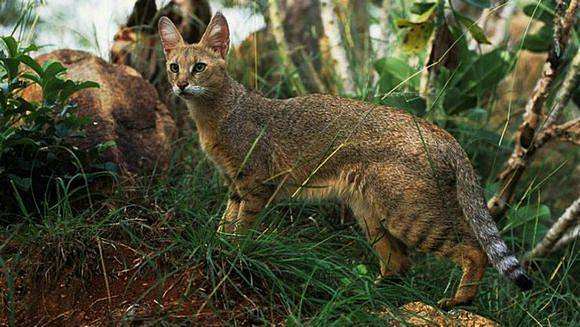Felis chaus
IUCN
LCBasic Information
Scientific classification
- name:Felis chaus
- Scientific Name:Felis chaus,jungle cat,Wild raccoon, raccoon
- Outline:Carnivora
- Family:felidae
Vital signs
- length:58-76cm
- Weight:5-9kg
- lifetime:12-14years
Feature
The largest cat species
Distribution and Habitat
Distribution extends from Egypt through the Middle East and Central Asia to India, Indochina and China.
Origin: Afghanistan, Armenia, Azerbaijan, Bangladesh, Bhutan, Cambodia, China, Egypt, Georgia, India, Iran, Iraq, Israel, Jordan, Kazakhstan, Kyrgyzstan, Laos, Lebanon, Myanmar, Nepal, Pakistan, Russia, Sri Lanka, Syria, Tajikistan, Thailand, Turkey, Turkmenistan, Uzbekistan, Vietnam.
Inhabits reeds or shrubs along rivers and lakes; coastal forests, or woods and fields with tall grass. Not found in tropical rainforests. Can be found in lowlands close to sea level, and can also be found in mountains at 2500 meters. Very adaptable to a variety of habitat types, common in agricultural areas. In the southern part of its distribution range, they also appear in sugarcane fields. Usually active near water, preferring dense vegetation, but also including barren desert areas. The rise of agricultural irrigation has led to the spread of jungle cat populations to such barren areas. They h
Appearance
The adult body is light brown, light reddish gray or light brown gray, with no obvious markings except for some stripes on the legs. Melanotic individuals have been reported in many areas. Except for the head, the black hair tips all over the body form a uniform mixture of colors, often showing rust color, and have a unique crest. The upper chin and throat, the chest between the legs and the groin are white to light gray. The ears are usually light red in color, closely spaced, and have small tufts of dark brown to black hair on the tips of the ears. There are conspicuous white spots on the eyes and snout, and dark spots from the nose to the eyes. The tail length is generally 40% of the head and body length, the tail tip is black, and there is a dark ring near the end of the tail. Males are significantly larger than females. Winter coat is darker than summer coat.
The cub is light brown all over, with several brown horizontal stripes on the upper limbs and the end of the tail, and 2
Details
The jungle cat is called jungle cat in foreign language. There are 9 subspecies, which are the largest species in the genus Cat. It is worth mentioning that jungle cats will occasionally have black individuals like black panthers. There are black jungle cats in Novosibirsk Zoo.

Wild raccoons are a mysterious (weird) animal in ancient my country. Maybe some people have heard about it from their elders, but they have never seen it in person. It is said that wild raccoons are the nemesis of domestic cats, and even hunting dogs are afraid of it. Once a domestic cat meets it, it has no resistance and can only follow it obediently. It will take the domestic cat to the river and let the domestic cat drink water continuously until it vomits. After the domestic cat washes its stomach, it will cut open the domestic cat's belly and enjoy it. In addition, there is also a description of wild raccoons killing cats in "Ghost Blowing Light: Wrath of the West Hunan". According to the research of experts and scholars, this wild raccoon is actually a jungle cat. So does the jungle cat "like to eat domestic cats"? Although there are phenomena such as lions killing leopards, leopards killing caracals, and caracals killing wild cats in the animal world, they are just bitten to death, and it is not normal. Cats generally do not feed on cats unless in extreme circumstances.
Jungle cats generally live alone except during the breeding season. Most of their nests are located in drier areas, such as under rocks or in abandoned badger holes. The home range is about 45~180km². They often appear at night, walk 5~6 kilometers at dusk every day, and live deep in the dense forest. They also come out to bask in the sun in winter. Jungle cats are hydrophilic cats, good at swimming, and can dive into the water to catch fish with their mouths.
Jungle cats are widely distributed in Iran, India and other places, but China is on the edge of its distribution, and the number is very rare (Cat Specialist Group, 1992). They are only found in the forest areas of Yunnan and the southern edge of Tibet, and the distribution range is limited. They are only occasionally seen in field surveys, and the survival rate in China is still unclear.
The cause of the jungle cat's endangerment is still under ecological investigation, but as a cat species with extremely limited distribution and only occasionally found, its skin is still being purchased and traded. It can be seen that strengthening protection, strictly prohibiting capture and hunting, and paying attention to the protection of its habitat are obviously urgent.
Listed in the "China Species Red List": Rare (R).
Listed in Appendix II of the Convention on International Trade in Endangered Species of Wild Fauna and Flora (CITES).
Listed in China's "National Key Protected Wildlife List": National First-Class Protected Animal (February 5, 2021).
Listed in the IUCN Red List of Threatened Species: Least Concern (LC), assessed in 2008.
Listed in the first level of the China National Key Protected Wildlife List.
Protect wildlife and eliminate game.
Maintaining ecological balance is everyone's responsibility!








